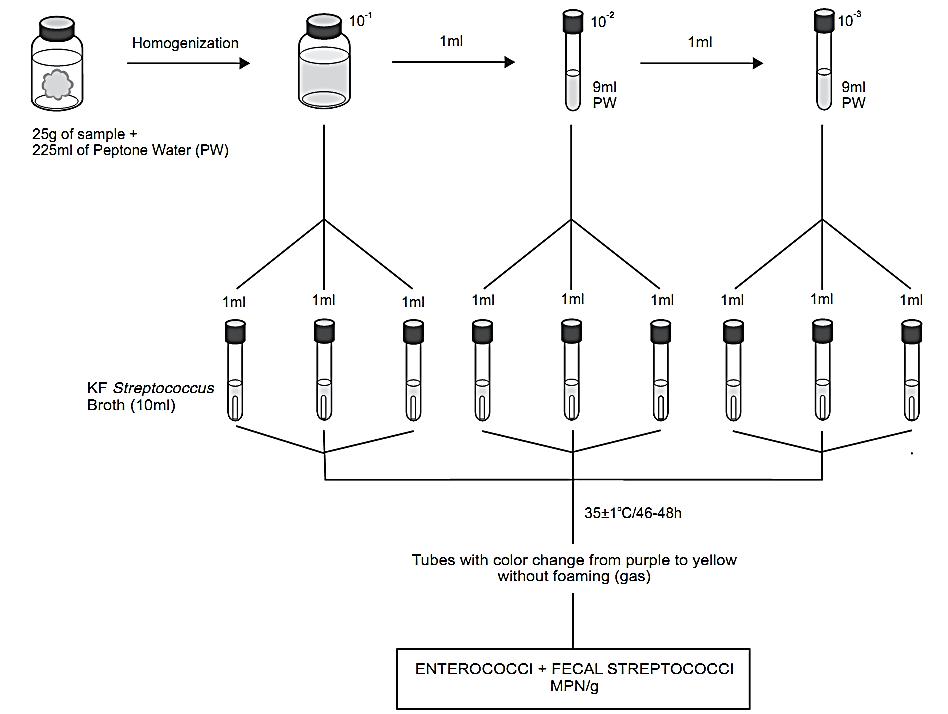
Most probable number (MPN) method APHA 2001 for enterococci and fecal streptococci in foods
 المؤلف:
SILVA, N.D .; TANIWAKI, M.H. ; JUNQUEIRA, V.C.A.; SILVEIRA, N.F.A. , NASCIMENTO , M.D.D. and GOMES ,R.A.R
المؤلف:
SILVA, N.D .; TANIWAKI, M.H. ; JUNQUEIRA, V.C.A.; SILVEIRA, N.F.A. , NASCIMENTO , M.D.D. and GOMES ,R.A.R
 المصدر:
MICROBIOLOGICAL EXAMINATION METHODS OF FOOD AND WATE A Laboratory Manual
المصدر:
MICROBIOLOGICAL EXAMINATION METHODS OF FOOD AND WATE A Laboratory Manual
 الجزء والصفحة:
الجزء والصفحة:
 14-3-2016
14-3-2016
 4399
4399
Most probable number (MPN) method APHA 2001 for enterococci and fecal streptococci in foods
The MPN method is recommended (but is not described) in the 4th Edition of the Compendium of Methods for the Microbiological Examination of Foods (Hartman et al., 2001) to detect low numbers of enterococci and fecal streptococci in foods. The description can be found in Difco & BBL Manual (Zimbro & Power, 2003).
1- Material required for analysis
Preparation of the sample and serial dilutions
• Diluent: 0.1% Peptone Water (PW) or Butterfield’s
Phosphate Buffer
• Dilution tubes containing 9 ml of 0.1% Peptone
Water (PW) or Butterfield’s Phosphate Buffer
MPN counting
• KF Streptococcus Broth
• Gram Stain Reagents
• Laboratory incubator set to 35 ± 1°C
2- Procedure
A general flowchart for the enumeration of enterococci and fecal streptococci using the Most Probable Number (MPN) method APHA 2001 is shown in Figure 1.
a) Preparation of the samples and serial dilutions:
For the preparation of the samples and serial dilutions. For dried foods the Compendium recommends to prepare a 1:1 initial dilution (sample 25 g+ diluent 25 ml), let it stand at 4°C/60 min and add the remaining volume of diluent to obtain a 1:10 dilution (200 ml).
b) Inoculation: Inoculate three 10 ml aliquots of the 10−1 dilution onto three tubes with 10 ml of double strength KF Streptococcus Broth, three 1 ml aliquots of the 10−1 dilution onto three tubes with 10 ml of single strength KF Streptococcus Broth, and three 1 ml aliquots of the 10−2 dilution onto three tubes with 10 ml of single strength KF Streptococcus Broth.
c) Incubation: Incubate the tubes at 35 ± 1°C/46–48 h.
Consider as enterococci and fecal streptococci the tubes showing growth (turbidity) and color change from purple to yellow without foaming (gas production).
d) Confirmation: Confirmation is required only for tubes showing gas production (foam) and is made by Gram staining (as described in chapter 5). Con-sider confirmed as enterococci and fecal streptococci the cultures of Gram positive cocci in pairs or short chains.
e) Calculation of results. Record the number of confirmed tubes and determine the MPN/g or MPN/ml using one of the MPN tables.

Figure 1. Scheme of analysis for the enumeration of enterococci and fecal streptococci in foods using the Most Probable Number (MPN) method APHA 2001 (Hartman et al., 2001, Zimbro & Power, 2003).
References
Silva, N.D .; Taniwaki, M.H. ; Junqueira, V.C.A.; Silveira, N.F.A. , Nasdcimento , M.D.D. and Gomes ,R.A.R .(2013) . Microbiological examination methods of food and water a laboratory Manual. Institute of Food Technology – ITAL, Campinas, SP, Brazil .
Hartman, P.A., Deibel, R.H. & Sieverding, L.M. (2001) Enterococci. In: Downes, F.P. & Ito, K. (eds). Compendium of Methods for the Microbiological Examination of Foods. 4th edition. Washington, American Public Health Association. Chapter 9, pp. 83–87.
Zimbro, M.J. & Power, D.A. (2003) Difco & BBL Manual of Microbiological Culture Media. Maryland, USA, Becton, Dickinson and Company.
 الاكثر قراءة في البكتيريا
الاكثر قراءة في البكتيريا
 اخر الاخبار
اخر الاخبار
اخبار العتبة العباسية المقدسة


